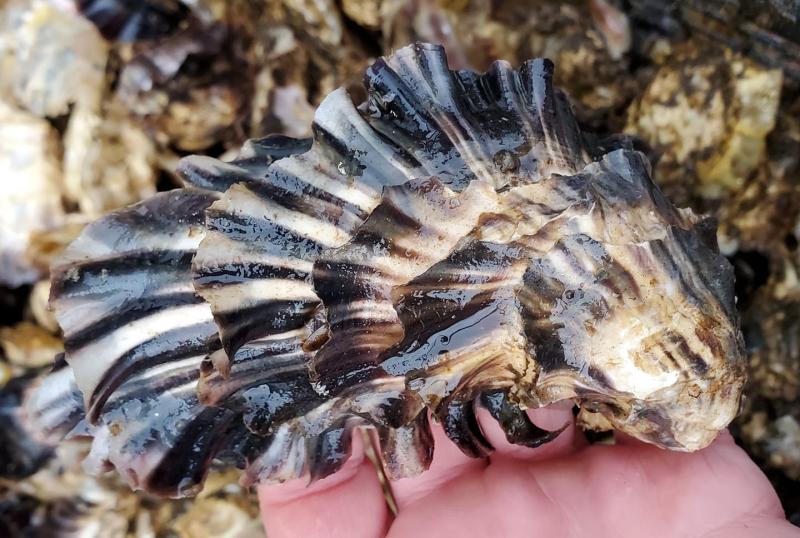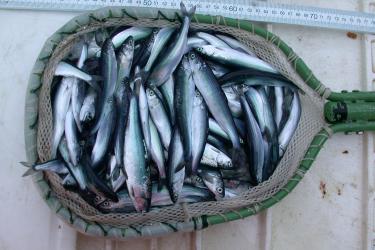Founded in 2010 by civil engineer Trevor Sande, Hump Island Oyster Company is a family-run business that farms oysters and kelp in Southeast Alaska. The company originally focused on oysters, but added bull kelp in 2016. The addition of kelp to their farm came after Barnacle Seafoods in Juneau suggested the fast growing crop to easily diversify the farm’s production.
A Focus on Sustainability
“The farm was created with a larger global community in mind, as Hump Island Oyster Company hopes to perfect the art and science of ocean farming in our unique region,” said Acting Farm Manager Shawn Sande. Hump Island has also helped to expand the region’s aquaculture industry by providing support, tools, and training to interested farmers.
Part of the appeal of aquaculture is that shellfish and kelp can have positive impacts for the environment. For instance, there are about 5 million oysters in the water at the Hump Island farm, filtering 250 billion gallons of water per day. Oysters also help prevent algae blooms caused by fertilizer runoff that gets into the water. If allowed to spread, algae blooms grow rapidly, use up the oxygen in the water, and can release harmful toxins into the ecosystem.
Adding to the ecosystem benefits of the shellfish farm, bull kelp pulls carbon out of the atmosphere. Kelp does not require land, fertilizer, or even freshwater to grow. As one of the fastest growing plants in the world (about 1 foot per day), kelp starts benefiting the surrounding environment almost immediately.
Hump Island also boosts its sustainability efforts by using renewable technology. The farm currently uses electricity from a local hydroelectric dam, but has plans to switch to solar power. “By switching to solar, we can reduce the amount of hours that we need our generator. Then we don’t have anything out there on the water that’s emitting carbon dioxide,” adds Sande.
From Farm to Table
Because the Alaskan summer waters are so cold, Hump Island oysters never get warm enough to spawn. Instead the farm purchases and cultivates Blue Hawaiian shellfish seed, or spat. The chilly water allows oysters to grow fatter all through the year. “Instead of spending sugars and fats on reproduction, the sugars go back into the meat,” explains Sande, “That’s how the nutrient-rich, low-temperature water that surrounds Hump Island contributes to the unique, bold flavor of our oysters.”
An on-site nursery provides suitable water flow for juvenile oysters to grow over the summer to about the size of a 50-cent piece. After that, the shellfish take a short boat ride to Hump Island where they hang in baskets suspended from cedar floats. The oysters are sorted and tumbled as they grow to develop deep meaty cups.
The oysters grow in the baskets for up to 3 years. In the summer, every basket of oysters is removed from the water two or three times to be tumbled. Tumbling helps shells grow uniformly, and provides the farm an opportunity to clean the baskets.
Once they reach market size, the oysters are harvested, processed, and shipped out to consumers and distributors all over the United States.
Fun Fact
The Sande family has a full tasting bar and restaurant along the farm’s waterfront. Patrons are invited to eat oysters and sip champagne as they sit on the dock and watch the aquaculture process.
Recipe: Grilled Oysters with Hump Island Secret Sauce
Grilled oysters with “secret sauce” are a favorite snack of the Hump Island Oyster Company crew.
Ingredients:
- 12 raw oysters
- Secret sauce
Secret Sauce Ingredients:
- 1 cube melted butter
- 2 tablespoons garlic, minced
- 1 tablespoon Sriracha sauce
Cooking Instructions:
- Heat grill to about 450°F.
- Mix sauce ingredients and let warm on the grill.
- Place whole oysters on the grill, cup side down. You will know they are fully cooked when the steam pops the shells open.
- Remove oysters from grill and drizzle with secret sauce.
Learn more about Hump Island Oyster Company
Sustainable Seafood from Tide to Table
The Tide to Table series profiles members of the aquaculture community, who provide valuable jobs and increase access to fresh, sustainably sourced American seafood. Aquaculture is about more than seafood production. It is about ecosystem stewardship, coastal communities, and economic opportunities.
Sources:






